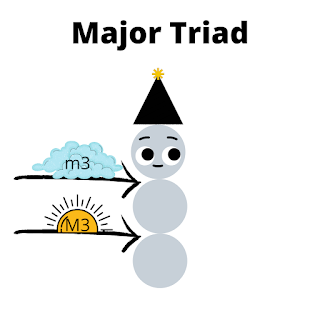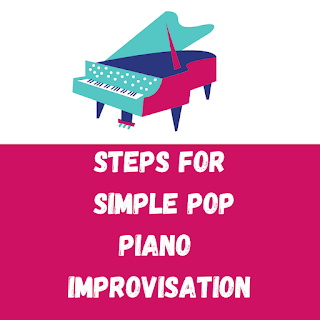Tuesday, November 29, 2022
Tuesday, November 8, 2022
Piano Accompaniment Patterns for Left Hand
Playing with a lead sheet gives you the power of choice to stylize songs however you like.
And there are so many options! Listen to a few below. Then choose some of your favorites to use as you accompany the melodies of simple folk or Christmas songs you already know.
Block Chords: Stacked up Like a Snowman
Block Chords with Syncopated Rhythm: Bop di Bop
Broken Chords: Oom-Pah
Alberti Bass: Bottom Top Middle Top
Broken Intervals: Chord Pieces
Forrest Gump Style: Interrupting Eighths
Piano Guys Ode to Joy (sheet music in Lullaby book)
Alberti + Broken Intervals + Forrest Gump
Bluesy 5-6 Swing Beetles
Bluesy Swayin' 1-5-6
Watch the following videos if you'd like to learn more left-hand styles and see them in action.
Thursday, October 13, 2022
12 Days of Halloween Piano Free Printable Rhythm Dictation Activity
Listen to the 12 Days of Halloween.
12 Days of Halloween with Lyrics
12 Days of Halloween Piano Version
Print the 12 Days of Halloween Free Printable.
Can you dictate rhythm patterns below each picture? Hint: 3 Black Cats= 3 Quarter Notes
1-Owl in a Rotten Oak Tree
2-Two Trick or Treaters
3-Three Black Cats
4- Four Skeletons
5- Five Scary Spooks
6- Six Goblins Gobbling
7- Seven Pumpkins Glowing
8- Eight Monsters Shrieking
9- Nine Ghosts a Booing
10- Ten Ghouls a Groaning
11- 'leven Caskets Creaking
12 Bats a Flying
Challenge: Can you change the "12 Days of Christmas" into the "12 Days of Halloween" by transposing it to the Relative Minor key? (Music on "Making Music Fun")
1- Add a flat to the 3rd and 6th notes of the scale. Remember to check the key signature!
2-Change the melody rhythms to match the Halloween lyrics. For example "Halloween" has more syllables than "Christmas" so change the quarter note in the first measure to an eighth note.
3-For an easier version add primary chord symbols (i, iv or V) above each measure and play as a lead sheet instead of playing the left hand as written.
Hint: Owl in a Rotten Oak Tree= i-iv-i-V-I
Saturday, June 25, 2022
Free Piano Improvisation Printable: Who Can Sail Without Wind?
If your piano lessons are focused on just reading music from the method books, improvisation can feel a bit scary. Some students are so stuck to the printed page they are scared to make mistakes.
This is similar to reading a speech from a script. But with a little guidance, exploring improvisation can be much more exciting than a speech read just like hearing a speech given from the heart can be more engaging than a recited speech from memory.
Monday, June 20, 2022
Review of "I Want to do What Jesus Taught" by Jerald Simon
"I Want to Do What Jesus Taught" by Jerald Simon
I was first introduced to Jerald Simon's music over ten years ago when I reviewed his "Cool Songs for Cools Kids" books. This energetic series has a lot of appeal for the teens and boys in my studio because of the video game, new age and fast-paced songs with repeating patterns.
He recently released a book of Christian primary songs, "I Want to do What Jesus Taught". This is definitely a different genre and style compared to the "Cool Songs" series.
I love that the central theme of the song lyrics focuses on basic Christian principles and values of prayer, kindness, and reliance on God and family.
It includes a good mix of slower calm songs and more upbeat energetic styles. Some songs are very short with just one or two lines that children could learn to sing easily in just a few minutes. Most songs are about 1 page in length with a single verse although a few include multiple pages and verses.
The melodies are easy to sing and I like that he chose lyrics that are understandable to children without complicated vocabulary words that would need explanations.
What pianist level is the book suitable for?
The difficulty level of the accompaniment of the majority of the songs is intermediate level. As a piano teacher, I like the wide variety of left-hand patterns found in the music including alberti bass, 2 8va arpeggios with finger crossings, 7th chords, and some simple intervals or chords.
Some of the large leaps and finger crossings may be more difficult for students with small hands to play, but I love that chord symbols are included in the music so accompaniments could be adapted if needed. The songs could also be played as lead sheets for additional chord variation practice.
There are a few songs limited to 5 finger position that a late elementary piano student could play, and others that are more advanced with 7 sharps or 4 flats that typical piano students wouldn't encounter until at an advanced level in method books.
If you are interested in learning more about how to improvise or compose using a variety of left hand patterns, check out this free YouTube video of Jerald's workshop "100 Left Hand Patterns Every Piano Player Should Know."
It definitely inspired me to want to experiment more with arranging!
Wednesday, March 9, 2022
Free Piano Teaching Game: Chord Match
Friday, February 11, 2022
Learn Piano Chord Progressions with Pop Songs: Try Every Key Challenge
Practicing chords doesn't have to be boring. I love to pair chord practice with pop songs since the majority of pop songs are limited to just 3 or 4 chords.
Although pop songs can have some pretty complicated rhythms for beginning piano students, they can enjoy accompanying YouTube videos with an understanding of chord symbols. Or they can sing along as they play the accompaniment. Choosing songs that they are familiar with really ups their ambition to practice and helps with audiation.
I've compiled a list of familiar primary songs from The Church of Jesus Christ of Latter day Saints with just 2 or 3 chords for my younger students, but having some fun pop songs in the makes chord practice more appealing for my older students.
Friday, January 14, 2022
Motivate and Track Piano Student Progress with Free Printable Piano Challenge Sheets
With so many different elements to teach in music lessons, it can be challenging to fit it all in. This year I've invited my piano students to complete a challenge each month that goes along with our monthly group lesson focus.
Although these concepts are woven into lessons throughout the year, having a focus theme and deadline makes it more likely for them to boost their skills. And it makes lesson planning simpler as the teacher!
If they successfully complete at least 10 challenges a year from this Piano Challenge Chart they get a surprise reward at the last Spring Group Lesson.
Monthly Piano Challenge Focus Topics
Notenaming/Interval ID
- Pass off a new level for the One Minute Club Challenge by naming and playing notes quickly.
- Bronze: Bass F-Treble G
- Silver: Bass C- Treble C
- Gold: Bass G- Treble F
- Master: Grand Staff + Ledger Lines
- Susan Paradis Notes in the Fast Lane Sheets are gradually leveled and easier than flipping flashcards for this activity.
Seasonal Composing/Improvisation
- Complete a challenge from the Halloween Surprise Me Sheet.
Accompanist Skills
The "Teaching Basic Accompanist Skills" post and Accompanist Tips Free Printable include helpful tips for beginners.
Arpeggios
- Can you play arpeggios in 12 keys?
Ear Training - Choose 1 challenge to complete
- Earn 90% or Higher on Listening Test
- Complete 30 levels on the bubble tones app
- Finish 10 Aural Games on TonicTutor.com free play mode.
The Expert Ears Challenge Free Printable includes links to activities students can try at home or during piano lab to prepare for their listening tests.
Theory
- Earn 90% or Higher on Theory Test
Use online practice links like Web Rewards, Teoria.com, Tonic Tutor.com, Heidispiano Quizlet to practice/prepare.
Earn 90% or Higher on Theory Test: Theory Skills by Level
Terms and Signs
- Earn 90% or Higher on Terms and Signs Test
This Free Printable Terms and Signs Study Sheets includes terms and signs definitions and symbols for various levels.
Scales/Chords and Chord Progressions
Rhythm
- Complete the next level of Rhythm Boss on the Rhythm Swing app or
- Count aloud and clap a Music Progressions Rhythm Sheet correctly at your lesson.
Technique
Thursday, January 13, 2022
Easy Piano Improvisation inspiration from YouTube
When I discovered this energetic new music video from the Truman Brothers this morning I had the itch to play along on the piano. While I don't have the music, I found it perfect as a "backing track" for a little A-flat improvisation. It could even be used for scale practice although I find improvising much more exciting!
Steps for Pop Song Style Piano Improvisation
Identify the Key.
This often can be done by matching the first or last pitch of the song on the piano. "Higher"is in A-flat. To improvise, start simply by creating melodies using the notes from the Aflat pentascale (A flat, Bflat, C, Dflat, Eflat). Later expand to include any note from the 1 octave scale.
Listen for repetitive elements in the song that you can incorporate in your own music.
I love the frequent bass IV-I Pattern from this song played in the intro. The simplicity of primary chords (I, IV, and V) with an occasional vi chord is common for pop style songs. You could simply play a Db followed by Ab in the bass or play octaves for a richer sound. Add in a few V chords or octaves for variety. To create a pop or rock feel, play repetitive measure quarter notes in the left hand.
For example. Ab-Ab-Ab-Ab then Db Db Db Db or Eb Eb Eb Eb.
Match the mood.
This pop style song has a steady drumming pulse that can be imitated by repetitive I, IV or V notes in the bass line with syncopated rhythms in the melody line. Choose a few of your favorite rhythm patterns in the song and imitate them as you improvise.
In the key of A flat the 1st, 4th and 5th notes of scale are all you need in the bass line.
- I-Aflat
- IV=Dflat
- V= Eflat
Here's my brief unrehearsed piano improv in A flat Major... still in my pjs! Improvisation doesn't have to be perfect, but it can definitely be fun!
Monday, January 10, 2022
Valentine's Day Piano Teaching Resource Roundup













.png)



